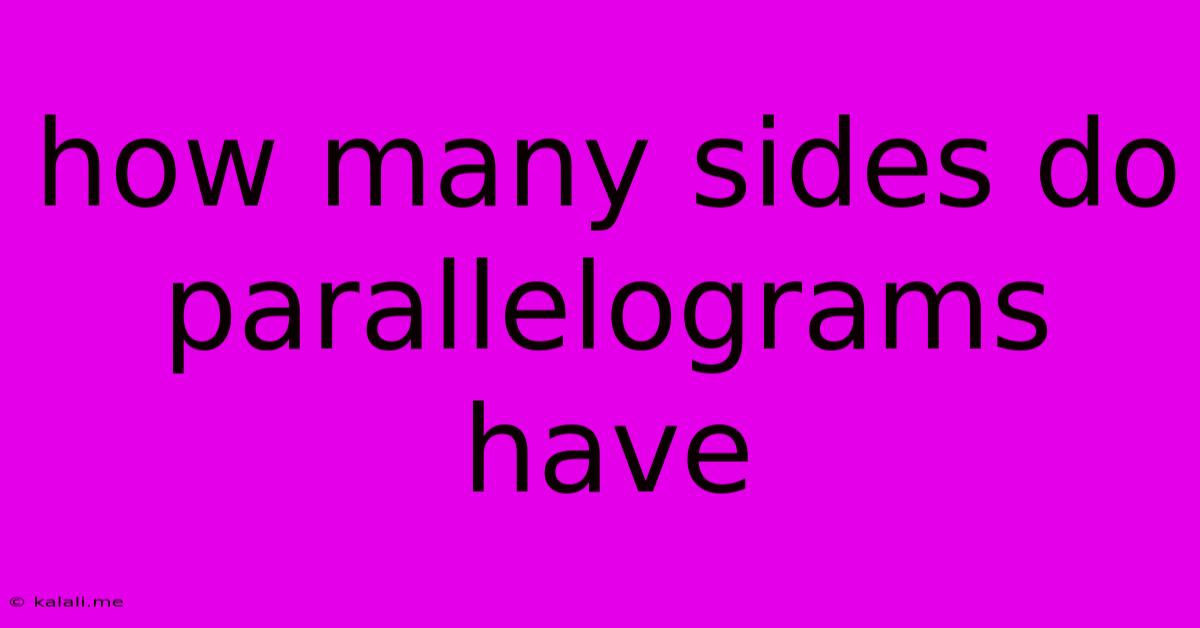How Many Sides Do Parallelograms Have
Kalali
May 09, 2025 · 2 min read

Table of Contents
How Many Sides Does a Parallelogram Have? A Simple Geometry Lesson
Meta Description: Learn the fundamental properties of parallelograms, including the number of sides they possess, and explore their unique characteristics in this concise geometry guide.
Parallelograms are fundamental shapes in geometry, and understanding their properties is crucial for anyone studying mathematics or related fields. One of the most basic questions about parallelograms is: how many sides do they have? The answer, simply put, is four.
However, understanding the number of sides is just the beginning. Let's delve deeper into the defining characteristics of this quadrilateral.
Defining a Parallelogram
A parallelogram is a quadrilateral, meaning it's a two-dimensional shape with four sides. But what sets it apart from other quadrilaterals like rectangles, squares, rhombuses, and trapezoids? The key defining characteristic is that opposite sides are parallel and equal in length. This parallelism is what gives the parallelogram its name.
Think of it like this: imagine pushing on opposite sides of a rectangle. You can slightly skew it, but the opposite sides will remain parallel and equal in length. That skewed rectangle is now a parallelogram!
Other Key Properties of Parallelograms
Besides having four sides and parallel opposite sides, parallelograms possess several other important properties:
- Opposite angles are equal: The angles across from each other are congruent (equal in measure).
- Consecutive angles are supplementary: Angles that share a side add up to 180 degrees.
- Diagonals bisect each other: The lines connecting opposite corners (diagonals) intersect at their midpoints.
Types of Parallelograms
It's important to note that parallelograms encompass a family of shapes. Squares, rectangles, and rhombuses are all specific types of parallelograms with additional properties:
- Rectangle: A parallelogram with four right angles.
- Square: A parallelogram with four right angles and four equal sides.
- Rhombus: A parallelogram with four equal sides.
Beyond the Basics: Applications of Parallelograms
Understanding parallelograms isn't just an academic exercise. These shapes appear frequently in real-world applications, from architecture and engineering to art and design. The inherent stability of their parallel sides makes them ideal for constructing structures and creating visually appealing patterns. Think of the tiles on a floor, the sides of a building, or even the shape of a bridge support.
Conclusion: Four Sides and Much More
So, the simple answer to "How many sides does a parallelogram have?" is four. However, exploring the properties of this fundamental shape reveals a world of geometric relationships and practical applications. Remember, while the four sides are a starting point, it's the parallel and equal opposite sides that truly define a parallelogram and its unique characteristics within the broader family of quadrilaterals.
Latest Posts
Latest Posts
-
152 Minutes Is How Many Hours
May 10, 2025
-
Quien Define El Sexo Del Bebe
May 10, 2025
-
What Does An Open Circle Mean On A Number Line
May 10, 2025
-
Cuanto Es 1 60 Cm En Pulgadas
May 10, 2025
-
14 Oz Is How Many Milliliters
May 10, 2025
Related Post
Thank you for visiting our website which covers about How Many Sides Do Parallelograms Have . We hope the information provided has been useful to you. Feel free to contact us if you have any questions or need further assistance. See you next time and don't miss to bookmark.